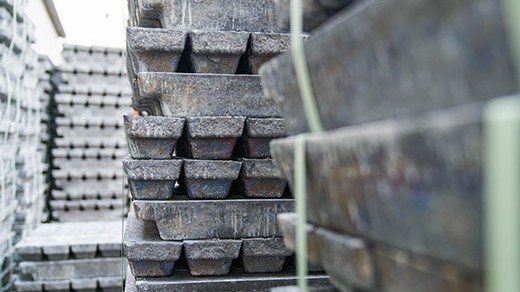
(The opinions expressed here are those of the author, Andy Home, a columnist for Reuters.)
The London lead market took a walk on the wild side last week.
London Metal Exchange (LME) three-month lead first charged higher, then collapsed as time-spreads blew out to their widest levels in a decade.
The turbulence peaked on Wednesday as bulls and bears slugged it out during the course of the LME’s monthly options expiry day. The bears appear to have won, with the price slumping from Wednesday’s high of $2,412.50 per tonne to $2,275.00 currently as spreads loosen again.

However, LME stocks are still super low and the physical supply chain remains super stressed, providing plenty of scope for more positioning clashes.
All the world’s lead seems to be in China, where warehouses are full to bursting. Some of that surplus should be seeping out through the arbitrage window but so far there has been little sign of movement.
Until Chinese exports flow, the already stark imbalances in global lead market risk could become even more extreme.
Wednesday’s LME traders were tussling over a tranche of call options – 800 lots (20,000 tonnes) – perched on the $2,400 per tonne strike price.
The cash-to-three-months spread leapt out to a backwardation of $89 per tonne, the highest LME cash premium since 2011, before shrinking to $23 per tonne by the end of the week and a currently indicated $15.
Part of the problem is low inventory. The LME’s most recent daily reports show two entities each sitting on 30-40% of available stocks and a dominant long holding cash positions equivalent to over 90% of stocks.
LME stocks currently total just 58,500 tonnes, down by almost 75,000 tonnes on the start of the year. Excluding the 18,925 tonnes awaiting physical load-out, available tonnage is just 39,575 tonnes, close to the decade low of 36,650 tonnes seen in 2019.
Beyond the London market-place, European supply has been hit by the outage at Germany’s Stolberg smelter, which last month declared force majeure due to flooding.
The U.S. market is even shorter of metal, with buyers paying record premiums of 15-18 cents per lb ($330-400 per tonne) over LME cash to get physical lead, according to Fastmarkets.
North American supply stress won’t be helped by reduced operations at Teck Resources’ Trail smelter in Canada, which last year produced 73,000 tonnes of refined metal. Lead smelting activity has been halted due to poor ambient air quality caused by wildfires.
Compare and contrast with the Chinese lead market.
Stocks of metal registered with the Shanghai Futures Exchange (ShFE) have surged by 136,000 tonnes since the start of January to 181,391 tonnes, the highest level recorded since the lead contract was launched in 2011.
Unsurprisingly, there’s not a hint of tightness across the front part of the forward curve and outright price action has been largely humdrum and sideways.
The LME lead price is still up by 10% on the start of the year even after its tumble at the end of last week. The Shanghai price, by contrast, is up by a mere 1%, with the large inventory overhang dampening speculative spirits.
Behind the stocks mountain lies a 21% jump in Chinese production of refined lead over the first half of the year, the highest production growth rate of any of the major industrial metals.
Evidently domestic demand hasn’t been able to keep pace, leaving a lot of surplus metal sitting in ShFE warehouses.
So far at least, it shows no signs of wanting to go anywhere.
China’s exports of refined lead totalled a meagre 1,038 tonnes in the first half of the year with just 51 tonnes leaving in June.
The country was a significant importer over 2017-2019 but inflows have almost dried up, although they still outpaced exports in the first half of 2021 to the net tune of 370 tonnes.
The lack of export response is surprising, given the clear signs of supply distress emanating from both the LME contract and the physical market.
However, it’s worth noting that a high 91% of the ShFE lead stocks are warranted, suggesting they may be sticky.
Arbitrage flows from China still seem the most likely salvation for lead buyers elsewhere, not least those short of LME time-spreads.
The International Lead and Zinc Study Group assesses a global supply surplus of 50,000 tonnes in the first five months of May but a lot more metal than that has surfaced in China, implying the world outside of China has been running a supply deficit.
Smelter outages such as those in Germany and Canada couldn’t have come at a worse time as the supply chain gears up to meet automotive demand for both replacement and new lead-acid batteries.
Throw in the continued disruption in global freight, particularly containerised freight such as used to transport refined metals, and the lead market outside of China is experiencing something of a perfect storm.
China can save the day but until it does, lead could be in for more wild times.
(Editing by Kirsten Donovan)
Comments